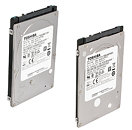Wednesday, January 7th 2015

Toshiba Launches New Generation Solid State Hybrid Drives
Toshiba Corporation's Semiconductor & Storage Products Company announced the launch of its new solid state hybrid drive (SSHD) series, which is equipped with Toshiba's 19nm second-generation NAND flash memory. The new "MQ02ABD100H" SSHD offers 1TB capacity in a drive 9.5mm high, while the "MQ02ABF050H" offers a capacity of 500GB in a 7 mm high form factor. Sample shipments will begin from February.
SSHDs deliver better performance compared to traditional hard disk drives (HDD), because the drives feature NAND that is used as the secondary cache during operation. This means users see improvement to the drive's performance compared to traditional HDDs, while still maintaining the equivalent capacities of traditional HDDs. The "MQ02ABD100H" and "MQ02ABF050H" are suitable for high-performance PCs like mainstream and gaming PCs, while the "MQ02ABF050H"'s height of 7mm makes it suitable for ultra-thin and ultra-portable computing devices.Toshiba's new generation SSHDs merge the NAND controller function into the main HDD controller chip. This all-in-one system on chip (SoC) for the "MQ02ABD/ABF-H" series enables more integrated management of the HDD and NAND operation compared to previous Toshiba SSHDs ("MQ01ABD-H" and "MQ01ABF-H" series) that featured separate NAND and HDD controller chips. With its engineering expertise and experience, Toshiba combines its NAND, HDD and SSD technologies to develop and produce SSHDs. Toshiba's NAND controller technologies unleash the NAND capabilities such as defective block management, ECC (Error Correction Code), conversion of logical block address and wear-leveling.
The new generation SSHDs also offer compatibility in both physical size and interface with traditional 2.5-inch HDDs. In other words, SSHDs allow for improved physical space efficiency within a system compared to alternatives that use a discrete SSD cache drive alongside an HDD. When using SSHDs, systems can access the drive through a single interface without the need for specific device driver software. Because it is a single unit, the SSHD is a lower cost alternative to SSDs while offering similar performance.
SSHDs deliver better performance compared to traditional hard disk drives (HDD), because the drives feature NAND that is used as the secondary cache during operation. This means users see improvement to the drive's performance compared to traditional HDDs, while still maintaining the equivalent capacities of traditional HDDs. The "MQ02ABD100H" and "MQ02ABF050H" are suitable for high-performance PCs like mainstream and gaming PCs, while the "MQ02ABF050H"'s height of 7mm makes it suitable for ultra-thin and ultra-portable computing devices.Toshiba's new generation SSHDs merge the NAND controller function into the main HDD controller chip. This all-in-one system on chip (SoC) for the "MQ02ABD/ABF-H" series enables more integrated management of the HDD and NAND operation compared to previous Toshiba SSHDs ("MQ01ABD-H" and "MQ01ABF-H" series) that featured separate NAND and HDD controller chips. With its engineering expertise and experience, Toshiba combines its NAND, HDD and SSD technologies to develop and produce SSHDs. Toshiba's NAND controller technologies unleash the NAND capabilities such as defective block management, ECC (Error Correction Code), conversion of logical block address and wear-leveling.
The new generation SSHDs also offer compatibility in both physical size and interface with traditional 2.5-inch HDDs. In other words, SSHDs allow for improved physical space efficiency within a system compared to alternatives that use a discrete SSD cache drive alongside an HDD. When using SSHDs, systems can access the drive through a single interface without the need for specific device driver software. Because it is a single unit, the SSHD is a lower cost alternative to SSDs while offering similar performance.

9 Comments on Toshiba Launches New Generation Solid State Hybrid Drives
hopefully not measly 8GB as they used to have...
64GB SSD, 32GB actually usable for caching. It would still be ridiculously cheap and provide like 400-500 TB of rewrites. Should be enough for anyone imo.
I would rather see a 16 to 32GB nand (depending on the capacity of the HDD) as STANDARD on ALL harddrives. Not just special line of hybrid drives.
And they would obviously have to cost similar to their non hybrid counterparts.
If things get integraded properly (like nand controller to the main hdd controller as they are doing now) this should be a possibility.
The purpose of nand cache is for it to be as cheap as possible and as effective as possible. Having 64GB flash makes little sense, since then you're better off getting a standalone drive.
Like i said, 16-32G max (lets say 16g for 1tb and 32gb for everything up) and litte added MSRP compared to normal drive. That would make a lot of sense. Everything else is just pointless, because like i said, you're better off getting a standalone ssd.
Miles better than integraded 64GB ssd into hdd.